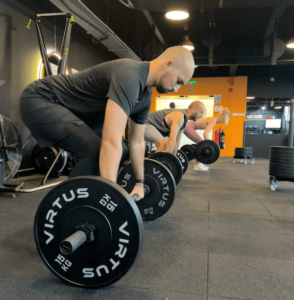Circuit Training for Weight Loss: Unlocking a Proven Fitness Strategy to Lose Weight

In the quest for effective weight loss, circuit training, like our circuit training class in Dubai called the Training Room, emerges as a dynamic and results-driven approach and workout program.
Unlike traditional workouts that focus on a single exercise, this type of training combines various exercises into one continuous routine.
From strength training exercises to cardio exercises, you use different exercises to get a great workout for the upper body and lower body with short rest intervals.
This concept not only adds excitement to your fitness journey but also accelerate and support weight loss.
Circuit training stands apart from conventional methods with its versatility. It combines cardio, strength, and endurance training, allowing you to burn calories efficiently while building lean muscle.
Unlike the monotonous treadmill or stationary bike, circuit training keeps you engaged by constantly varying exercises.
This approach triggers the afterburn effect, also known as excess post-exercise oxygen consumption (EPOC).
It means your body continues to burn calories even after your workout, aiding in weight loss. Circuit training doesn't just rev up your metabolism; it also strengthens your heart, improves cardiovascular fitness, and enhances muscular endurance.

What sets circuit training apart is its adaptability to different fitness levels. Whether you're a beginner or an experienced fitness enthusiast, circuit training can be tailored to suit your needs.
It's an inclusive fitness strategy that's accessible to all, and it thrives on the sense of community and shared motivation.
If you're looking for an efficient and engaging way to lose weight, circuit training is your answer. Circuit training stands out as a dynamic and efficient exercise regimen tailored for those seeking to shed pounds effectively while enjoying a sense of community.
The science supporting circuit training's prowess in weight loss is nothing short of fascinating.
Beyond the evident physical transformations, there's a wealth of psychological benefits when you train within a community.
The sense of shared purpose and mutual encouragement can be a powerful motivator. With every circuit completed, the sense of accomplishment fuels not only your body but also your mental resilience.

Scientifically, circuit training is grounded in the principles of high-intensity interval training (HIIT), which triggers an 'afterburn effect.'
This metabolic surge continues long after your workout, maximizing calorie burn. Furthermore, circuit training strategically targets various muscle groups, optimizing muscle retention as you lose weight.
Circuit training is a dynamic exercise regimen that blends strength and cardiovascular training into a single, seamless workout.
In this method, you move through a series of diverse exercises, each targeting different muscle groups. These exercises are performed consecutively with little to no rest in between, creating a circuit.
Typically, circuit training includes a mix of bodyweight exercises, resistance training, and cardiovascular activities, such as jumping jacks or jump rope.

The versatility of circuit training allows you to customize workouts, making them suitable for various fitness levels and goals.
Unlike traditional workouts that isolate specific muscle groups, circuit training offers a comprehensive approach, engaging the entire body.
This not only enhances muscular endurance but also elevates heart rate, promoting calorie burn and weight loss.
The Core Principles of Circuit Training
At the heart of circuit training lie several fundamental principles that make it an effective fitness regimen. Circuit training is designed to challenge the body through a combination of elements:
Variety:
Circuit training incorporates diverse exercises, targeting different muscle groups. This variety prevents workout boredom and overuse injuries.
Intensity:
The high-intensity nature of circuit training stimulates the cardiovascular system and promotes calorie burn. It encourages participants to push their limits.
Efficiency:
Circuits are structured with little to no rest between exercises, optimizing time efficiency. This intensity also triggers the afterburn effect, where your body continues to burn calories post-workout.
Full-Body Engagement:
Circuit training provides a full-body workout, ensuring balanced muscle development. It combines strength and aerobic exercises for comprehensive fitness.
Adaptability:
Circuits can be tailored to suit individual fitness levels and goals, making them accessible to beginners and challenging for advanced athletes.
Understanding these core principles underscores why circuit training is a favored choice for those seeking efficient and effective workouts.
The Evolution of Circuit Training: From Military Roots to Comprehensive Fitness

Circuit training has a rich history that traces its origins back to military training. Developed in the early 1950s by Royal Navy Dr. Thomas L. DeLorme, the method aimed to rehabilitate World War II soldiers. Its effectiveness soon caught the attention of the broader fitness community.
Originally known as "DeLorme's Protocol," circuit training was designed to help injured soldiers regain their strength systematically.
It involved performing a series of resistance exercises with minimal rest between sets. This approach helped improve muscle endurance and overall fitness levels.
Over time, circuit training evolved beyond rehabilitation. It became a popular fitness regimen for athletes and enthusiasts looking to enhance their stamina, muscular endurance, and cardiovascular fitness. Its versatility and effectiveness led to its adoption in sports training, gyms, and fitness classes.
Today, circuit training remains a cornerstone of fitness programs, appreciated for its ability to deliver well-rounded workouts.
Its military roots have translated into civilian fitness, benefiting individuals seeking a time-efficient, high-intensity exercise method that enhances both physical and mental endurance.
The Scientific Connection
Circuit training stands out as an effective strategy for weight loss, supported by scientific research. The combination of resistance exercises and cardiovascular elements in circuit training creates a potent fat-burning environment.
Scientific studies have consistently shown that circuit training contributes to significant calorie expenditure during and after workouts.
This phenomenon, known as the afterburn effect or excess post-exercise oxygen consumption (EPOC), results in continued calorie burning even after the workout ends. It's triggered by the body's efforts to repair and replenish muscle tissues.

Moreover, circuit training targets multiple muscle groups simultaneously, promoting lean muscle mass development. Muscle tissue burns more calories at rest than fat tissue, making it a valuable asset for weight management.
A study published in the "Journal of Sports Science & Medicine" found that circuit training workouts led to improved body composition, reduced fat mass, and increased lean muscle mass in participants.
Another study in the "Journal of Strength and Conditioning Research" confirmed the effectiveness of circuit training in enhancing cardiovascular fitness and promoting weight loss.
These findings underscore the role of circuit training as a scientifically-backed approach to weight loss and overall fitness improvement.
MUSCLE TARGETING FOR CALORIE BURN

Circuit training's effectiveness in calorie burn and muscle targeting is rooted in its unique design, making it a top choice for those seeking weight loss and improved fitness.
One key factor in circuit training's efficacy is its ability to engage different muscle groups within the same workout session.
Traditional workouts often focus on a single muscle group, limiting calorie expenditure. In contrast, circuit training incorporates a series of exercises that address various muscle groups. This holistic approach creates a higher demand for energy, resulting in increased calorie burn.
The afterburn effect, scientifically known as excess post-exercise oxygen consumption (EPOC), is a crucial component of circuit training.
This phenomenon occurs when the body continues to burn calories at an elevated rate even after the workout ends. EPOC is triggered by the need to repair muscle tissues and restore the body to its pre-exercise state.
Circuit training, with its high-intensity intervals and diverse exercises, promotes EPOC more effectively than steady-state cardio exercises.
During circuit training, the combination of strength and cardiovascular elements leads to a spike in heart rate and oxygen consumption.
This results in a higher calorie expenditure, even when compared to longer-duration aerobic exercises. Studies, such as one published in the "Journal of Applied Physiology," confirm that high-intensity interval training, a component of circuit training, significantly enhances EPOC and calorie burn.
The Benefits of Circuit Training Workouts Don't Stop There
Numerous medical studies have illuminated the profound psychological impacts of circuit training, particularly when performed in a group setting.
Research has consistently shown that participating in circuit training within a supportive community fosters a sense of camaraderie and shared purpose.
This group dynamic can have substantial positive effects on mental well-being, reducing stress and anxiety while enhancing motivation and adherence to fitness routines.

Furthermore, the social interaction inherent in group circuit training can combat feelings of isolation, promoting a sense of belonging. These psychological benefits, substantiated by scientific studies, underscore the holistic advantages of circuit training beyond physical fitness.
Circuit Training Workout: DIY vs Professional Guidance

Adding circuit training to your gym regimen can be a game-changer in your fitness journey.
Whether you decide to go the DIY route or seek professional guidance, here's how to get the most out of this dynamic training method.
Do It Yourself (DIY) Circuit Training
Implementing circuit training on your own can be empowering and flexible. You have the freedom to choose exercises, duration, and intensity levels. To make the most of it, follow these tips:
Variety is Key:
Create a well-rounded circuit that targets different muscle groups. Incorporate bodyweight exercises, free weights, and cardio intervals.
Proper Form:
Prioritize form over speed. Correct technique not only reduces the risk of injury but also ensures that muscles are engaged effectively.
Interval Timing:
Designate specific time intervals or repetitions for each exercise. Maintain a balance between work and rest periods.
Progressive Overload:
Regularly challenge yourself by increasing weights, repetitions, or intensity. This keeps your body adapting and burning calories efficiently.
Professional Circuit Training Workouts:
Enlisting the expertise of a fitness professional can elevate your circuit training experience. Here's how:
Tailored Workouts
Professionals create customized circuits that align with your fitness goals, whether it's weight loss, muscle gain, or overall fitness.
Structured Progression
They design programs with gradual difficulty progression, ensuring you're consistently challenged and making advancements safely.
Variety
Trainers introduce diverse exercises, preventing workout monotony and targeting muscle groups comprehensively.
Proper Guidance
Having a trainer by your side guarantees proper form, reducing the risk of injuries and maximizing results.
Motivation
Professionals provide the motivation and accountability needed to stay on track.
Ultimately, whether you choose a DIY approach or work with a professional, circuit training's success hinges on variety and proper form. Assess your preferences, goals, and available resources to decide the best path to achieving your fitness ambitions.
RECAP ON THE SCIENCE BEHIND WEIGHT LOSS IN CIRCUIT TRAINING
Circuit training's effectiveness in weight loss is firmly rooted in scientific principles. Research supports the impact of this training method on shedding excess pounds.

Calorie Burn
Circuit training's high-intensity nature elevates heart rate and increases calorie expenditure. Studies like the one published in the "Journal of Sports Science & Medicine" have demonstrated that intense circuit workouts can burn up to 30% more calories compared to traditional workouts.
Metabolism Boost
Engaging multiple muscle groups simultaneously, as emphasized in circuit training, accelerates the metabolism.
A study in the "Journal of Translational Medicine" found that such workouts trigger a significant post-exercise energy expenditure, contributing to long-term weight loss.
Muscle Retention
Retaining lean muscle mass is vital for effective weight loss. Circuit training not only promotes fat loss but also helps maintain and build lean muscle.
A study in "Obesity" showcased that resistance-based circuit training positively influenced body composition by preserving muscle.
Afterburn Effect
Circuit training induces excess post-exercise oxygen consumption (EPOC), commonly known as the afterburn effect.
Research in the "Journal of Strength and Conditioning Research" shows that intense circuit workouts lead to extended calorie burning even after the exercise session concludes.
These scientific findings emphasize the effectiveness of circuit training as a potent tool for weight loss. Its combination of calorie burn, metabolic boost, muscle retention, and the afterburn effect makes it a well-rounded approach for those aiming to shed extra pounds.

